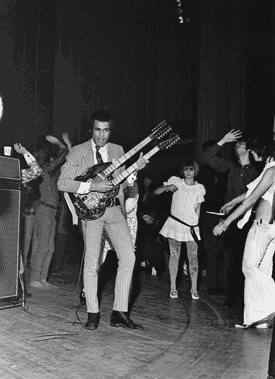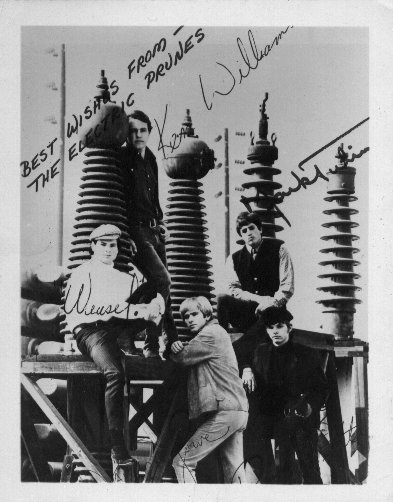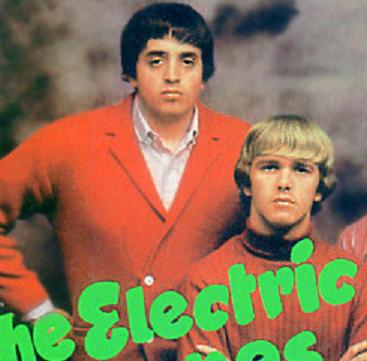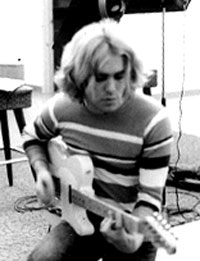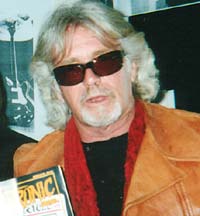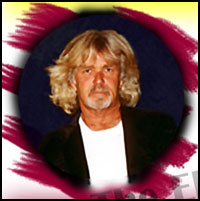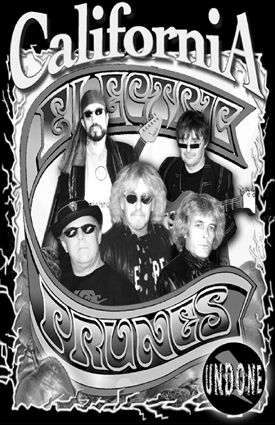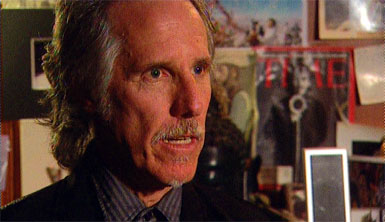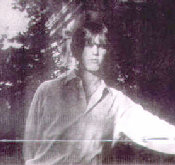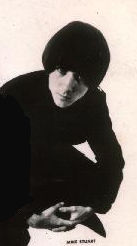 | Anatomy of a ĎRiotí, Sunset Strip 60th |
|
Johnny Echols (The Love) at the Hullabaloo in 1966 |
The Electric Prunes |
Mark Tulin, James Lowe, 1967 |
|
James Lowe in 1972 |
J. Lowe |
J.Lowe |
|
|
Michael Stuart-Ware, 2006 |
John Densmorewas very flattering about Love and the influence that they had on The Doors |
|
Bryan MacLean, The Love |
Michael Stuart-Ware, 60th |
|
http://www.lacitybeat.com/article.php?id=5783&IssueNum=213
~ By NATALIE NICHOLS ~
Iím going down to the Strip tonight
Iím not on a stay-home trip tonight
Long hair seems to be the main attraction
But the heat is causing all the action Ö
ĖThe Standells, ďRiot on Sunset StripĒ
That was the scene in November 1966, as police cracked down on teenagers protesting draconian enforcement of a curfew intended to keep them off the Sunset Strip. Along this magical stretch between Crescent Heights and Doheny, kids had thronged clubs like the Whisky a Go Go, Ciroís, the Trip, and Pandoraís Box for nearly two years Ė mingling, dancing, and watching the Byrds, the Doors, Love, Buffalo Springfield, the Standells, and many other eventually iconic rock bands. It was a vibrant creative interlude that, as author Domenic Priore writes in his new book Riot on Sunset Strip (Jawbone Press, paper, $29.95), ďhas given our world immeasureable color and contributed to much positive social change.Ē
But, as conveyed by the brash guitar lead and howling sirens on the Standellsí theme to 1967 teensploitation flick Riot on Sunset Strip, the thrill of the new soon clashed with the will of the old. And, despite youth outrage and even parental objections, baton-wielding sheriffís deputies quickly put a stop to the freewheeling fun.
Prioreís book Ė including a foreword by the late, great Arthur Lee of Love Ė arrives just as the popcult cuckoo clock heralds the 40th anniversary of the Summer of Love. (Gee, seems like just yesterday it was the 30th anniversary of the Summer of Love.) These repetitive milestones are tiresome, but the í60s remain a fabled era of innovation and evolution. After all, back then a former Mouseketeer Ė namely, Standells singer-drummer Dick Dodd Ė could grow up to become a cool, socially conscious garage-rocker instead of an empty-headed product ŗ la Britney, Justin, and Xtina. Riot reminds us that, in those days, teen culture was the tail that wagged the capitalist running-dogs, and not the other way around.
But mostly, the book demonstrates that Los Angeles was a virtually unparalleled í60s crucible for the underground fusion of music, visual arts, and activism that flowered in mainstream culture during the Summer of Love. Priore conveys the excitement, as well as the turmoil, of change. Still, Riot has a pervasive sense of doom.
ďI see this story as a tragedy,Ē says Priore, a longtime acquaintance who, full disclosure, includes me among the bookís long list of ďthose who helpedĒ (although Iím not sure why). ďAnd I think the most dismaying thing is how people perceive [that time] now: San Francisco was the god city, and Manson was what L.A. was about. I am hoping the book might change some of those opinions.Ē
An obsessive pop-culture historian whose 1995 Look! Listen! Vibrate! Smile! remains the definitive book about the Beach Boysí legendary lost album Smile, Priore scoured old copies of the L.A. Free Press, culled info from liner notes, and tracked down vintage photos to create a vivid sense of time and place. His fascination with minutiae can be head-spinning, but the details make Riot a compelling exploration of the historical, political, racial, and cultural contexts affecting the Strip, and L.A. itself, as far back as the 1920s.
ďItís hard to capture the essence of a scene as a whole,Ē says the L.A. native, and thatís an understatement. He was only five in 1965 but caught occasional fleeting glimpses of the Strip from the family car, as well as hearing about it from older siblings who were there. He also saw many Strip bands on Shindig!, Hollywood a Go Go, and numerous other L.A.-based rock TV shows of the day. These memories fueled his curiosity about how this impromptu movement arose, and he works hard to show how various discrete local scenes Ė Chicano rock, Venice beats, rockabilly, surf, folk, R&B, as well as art movements, comedy, and film Ė crossed paths and cross-pollinated with the Strip scene, which was also fed by and in turn influenced such American heroes as Bob Dylan and British stars as the Rolling Stones.
The demise of it all is tragic indeed, but the ďAftermathĒ chapter may be more depressing, delineating how much the Strip has changed. When you look at the old photographs of the street, you can recognize the outline of whatís still there. But when you actually travel down the boulevard, no trace of those days remains
Domenic Priore, with special guests Michael Stuart-Ware (former Love drummer) and Jim Lowe and Mark Tulin (of the Electric Prunes), appear at Book Soup, 8818 Sunset Blvd., West Hollywood, on Thur., July 12,2007 at 7 p.m. (310) 659-3110 or Booksoup.com.
The following is an interview with James Lowe conducted via snail mail in February / March 1998.
I have been pondering on the questions to ask you for a while! I have tried to avoid questions that have been asked many times before. Oh well, here goes (sorry if the list is rather long!) :
Thank you for the interest in a rather obscure group. We are always amazed when anyone remembers anything about our band. Hope these answers are enough to justify your nice letter.
1. What did you do before forming the Electric Prunes?
Surfed in Hawaii and California, got interested in performing by playing blues and bluegrass in a coffeehouse with a friend on talent nights. Was friends with Dick Dale in Newport Beach California so I was interested in surf guitar music.
2. Did the band have any other names before you settled on The Electric Prunes and where did the name come from?
We were the "Sanctions" at first and "Jim and the Lords" next. Got the name Electric Prunes by locking ourselves in our practice room till we came up with something to put on our first release on Reprise "Ain''t It Hard". The record company balked at first at the name but gave in when we wouldn''t change our minds. Mark told a joke that ended with an Electric Prune punchline and I seized it as a great name for us as I recall.
3. What musical influences did the band draw upon?
Byrds, Muddy Waters, Challengers, Stones, Little Willie John, Lightin'' Hopkins.
4. Who decided on doing the cover version of "Ain''t It Hard" and releasing it as the first Prunes single?
Dave Hassinger and Jimmy Bowen, though we did not know it had ever been recorded before. The writer was there at the session and this made it tough to stray too far from the way he had written it.
5. Why was Michael Weakley (aka ''Quint'') replaced by Preston Ritter after this single?
Mike Weakley was always looking for a better deal and didn''t think things were moving fast enough with Reprise. This lack of satisfaction characterized his personality both times he was in the band, after all he was a drummer and they are all crazy. He returned the second time as "Quint"; donít know why? He was a great live drummer.
6. Why did both Preston Ritter and James ''Weasel'' Spagnola leave during the recording of the "Underground" album?
Preston Ritter was a softspoken drummer (this did not compute to me as I felt we needed drive in the beat department). We also had some personal differences. He was technical and precise as a drummer.
7. The "Underground" album included more songs written by the band then the first, were the band disappointed that the singles released from the album didn''t make as big an impact on the charts as the first few did?
Yes, we weren''t allowed to put our songs on the first recordings as Dave Hassinger had commitments to writers under contract to him. We did not agree with the singles released after the first few except for "Everybody Knows" b/w "Youíve Never Had It Better", those were my mistakes.
8. What caused the radical shift in musical direction from the release of the single "Everybody Knows You''re Not In Love / Youíve Never Had It Better" to then release "Mass in F Minor"?
We were talked into "Mass in F Minor". It was a commercial attempt at psychedelic music. We were into major differences with Hassinger at this time and he owned the name (our stupidity). Witnessed by the release of albums after we all were gone that were shit. At least our shit was our shit!
9. I read one interview that you were involved in the "Mass in F Minor" sessions. Who else was involved in this recording?
The entire band played on the first three cuts, we didn''t move fast enough in the studio (the charts were written out note for note). We were not used to this format, we were after all a f***king garage band! Mark, Quint and I played on the rest of the album with guys from the Collectors, another Hassinger property. Dave never had another chart record after us, so much for the rumour that he developed us.
10. Why did you eventually leave the band?
Touring, assholes, lack of interest. I couldn''t get along with my wife for very long either.
11. Did the others leave at the same time as you?
I left in the middle of a tour in Texas, the band tried to go on for about two months more as I understand. The subsequent band was in no way related to us. Hassinger tried to cash in.
12. What did you do after leaving the band?
Produced and engineered records.
13. "Stockholm ''67" released in 1997 showed that the Prunes were not only a studio band. Were you surprised that the masters of the radio broadcast had survived and subsequently released commercially?
Simon Edwards from Heartbeat was responsible for that record. David Katznelson from Reprise kindly let him do it. I had contact with Simon, and was allowed to have input on the Stockholm ''67 release. This was a very positive experience.
Too bad this was at the end of the tour and we didn''t give our best performance. The fact that the tape even existed is a small miracle. We didn''t want them to record that night as we had prepared a rather dull set. Most of the gigs we played in Europe ended with audiences open-mouthed at all the feedback and such, so we kept changing song selection around to try to find some connection with the people we were playing for. In retrospect this was probably not the best thing to do; but hindsight is always 20/20!
14. Have you kept in touch with any of the other band members?
Mark Tulin and I are friends.
15. Would you ever consider a "reunion" of the original Electric Prunes if the time / conditions were right?
Mark Tulin, Preston Ritter (alternate drummer) and I have been making noise with a few friends lately. We have tried to locate the other members of the group for old times sake.
16. Do you know what the current status of the new Electric Prunes compilation by Reprise is? It was scheduled for release on 10th March 1998 according to Reprise''s web site but the entry has subsequently disappeared.
The release date for the "Lost Dreams" album keeps getting pushed back; what else is new? I think it will come out eventually. David Katznelson is the reason the project went forward, he is a good guy. I was allowed to remix songs we had released before, and mix a few we never finished. After the band split I engineered albums for Grapefruit, Foghat, Nazz, Todd Rundgren, Randy Neuman, Ry Cooder, Sparks and others, so it was like reliving my musical youth to be involved in that way again. David even let me do the CD cover for the project and put the album together the way I wanted.
17. What is your favourite Prunes single and why?
"You''ve Never Had It Better", it was rough and garage sounding.
18. Finally (I think), if you have any other information about the Prunes, I would love to hear about it.
We did get to England on a tour once; but we did not enjoy much popularity or chart action there. That tour will always be one that stands out in my mind as we had a great time in music history. Everything from the Speakeasy to the Marquee Club is just as fresh as yesterday. England was where it was all happening.
We were very lucky for the experience
James Lowe
The second Sparks'' Lp was called "A Woofer In Tweeter''s Clothing" (not to be confused with the early demo tape) and this album was produced by Thaddeus James Lowe (ex-singer of The Electric Prunes). It remains Sparks'' most curious Lp, possibly because of its lack of attention. The songs were far less accessible in an instant way, and many were fragmented in the extreme. "Girl From Germany", the most normal sounding song from the album was released as a single, with "Beaver O'' Lindy" on the b-side. "A Woofer In Tweeter''s Clothing" became a misunderstood classic : It didn''t sell either.
Thaddeus James Lowe (producer). Thaddeus James Lowe was the singer of the Electric Prunes a legendary band who had had a hit in the 60''s with a song called "I Had Too Much To Drink Last Night". Thaddeus James Lowe was with Todd Rundgren and Miss Christine (ex-GTO''s) when they went to see Halfnelson practice out in "The Doggie Bed Factory". - read more...
Thaddeus James Lowe had engineered Nazz and Runt and a few other albums with Todd Rundgren and that is why he became involved. Thaddeus James Lowe engineered the "Halfnelson/Sparks" very first album which was produced by Todd Rundgren. Todd was doing some other project and couldn''t produce the second album so Sparks asked Thaddeus James Lowe if he would be interested. Thaddeus James Lowe did "A Woofer In Tweeter''s Clothing" Lp as a producer. - read more...
Once he heard Sparks/Halfnelson, Thaddeus James Lowe became entranced with the "left handed" approach they were taking to music since he had tried a version of that with The Electric Prunes a few years earlier. Thaddeus James Lowe used his full name on that album because it was special to him (He has never used it on anything else).
Thaddeus James Lowe stopped making records in part because "A Woofer In Tweeter''s Clothing" was not successful. It was a deal he made with his wife saying : "If this thing doesn''t qualify as a good album I will find something else to do."... Thaddeus James Lowe went into the film business !
Twenty five years ago, Thaddeus James Lowe bought 20 or so acres in a remote part of Southern California, in the hills north of Santa Barbara. At the top of one of the hills he built a beautiful home. - and he built it himself ! Then this remote area became very popular with movie stars and wealthy exectives.
In this house, Thaddeus James Lowe & original members of the Electric Prunes had started recording some tracks during the summer of 1999. For the first time in over 30 years, the original Electric Prunes line-up have reformed to release an album called "Artefact". A brand new Electric Prunes Cd is still in
Riot on Sunset Strip
California - play Electric Prunes
James Love
The Electric Prunes
The Love
